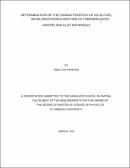| dc.description.abstract | This study was driven by the fact that plenty of plastics which have potentials to be used as
source of fuel are left as wastes in the environment without proper utilization. The study was
directed toward the use of a particular type of plastics for making a plastic based solid fuel and to
find its viability for use as source of energy. Polyethylene – terephthalate (PET) material
obtained from waste mineral water bottles and ball clay were mixed to form PET – Clay Solid
Fuel (PETCSF) product. Clay was mixed with plastics to avoid melt flowing or dropping of the
fuel in the stove during combustion.
The parameters of the developed PETCSF those were determined to find its viability as source of
energy were Mass of melt drops, mass combustion rate, mass of ash and the calorific value. The
following Clay Plastic Ratio (CPR) 1:2.43, 1:2.33 and 1:1.20 were found to be sufficient in
stopping melt dropping behavior of the developed solid fuel in the stove during combustion.
The calorific values of the PETCSF were found to be 14,335 J g-1, 14,170 J g-1 and 11,182 J g-1
for CPR = 1:2.43, 1:2.33 & 1:1.20 respectively. Calorific values of an equal mass of charcoal,
paper and Benzoic acid tablet (used as reference solid fuel materials) were 7,316 J g-1, 12,475 J
g-1 and 24,239 J g-1 respectively. The mass combustion rates for CPR = 1:2.43, 1:2.33 & 1:1.20
were found to be 2.45 g minute-1, 2.43 g minute-1 and 1.98 g minute-1 respectively. The mass of
ash left after combustion for the above respective CPR values were 36.64 g, 37.37 g and 50.73 g
respectively.
When compared, the calorific value of the developed PETCSF was found to be about two times
higher than for charcoal of an equal mass. Benzoic acid tablet had the highest calorific value.
Thus, PETCSF is a viable source of fuel compared to charcoal in terms of the calorific value and
moreover its combustion rate can be controlled by using a specific CPR of 1:2.43 as shown by
the result of the study.
The population should be encouraged by the findings in this study and to begin thinking of using
plastic based solid fuel as an alternative to charcoal and firewood which currently are the only
predominant sources of fuel for majority of the population. The used plastic based solid fuel in
an oxygen rich environment (or sufficient air circulation) is strongly recommended as complete
combustion is guaranteed. Insufficient air supply may lead to incomplete combustion of the fuel
and possibly release of particles (soot/smoke) which if inhaled may be harmful to the user. | en_US |

